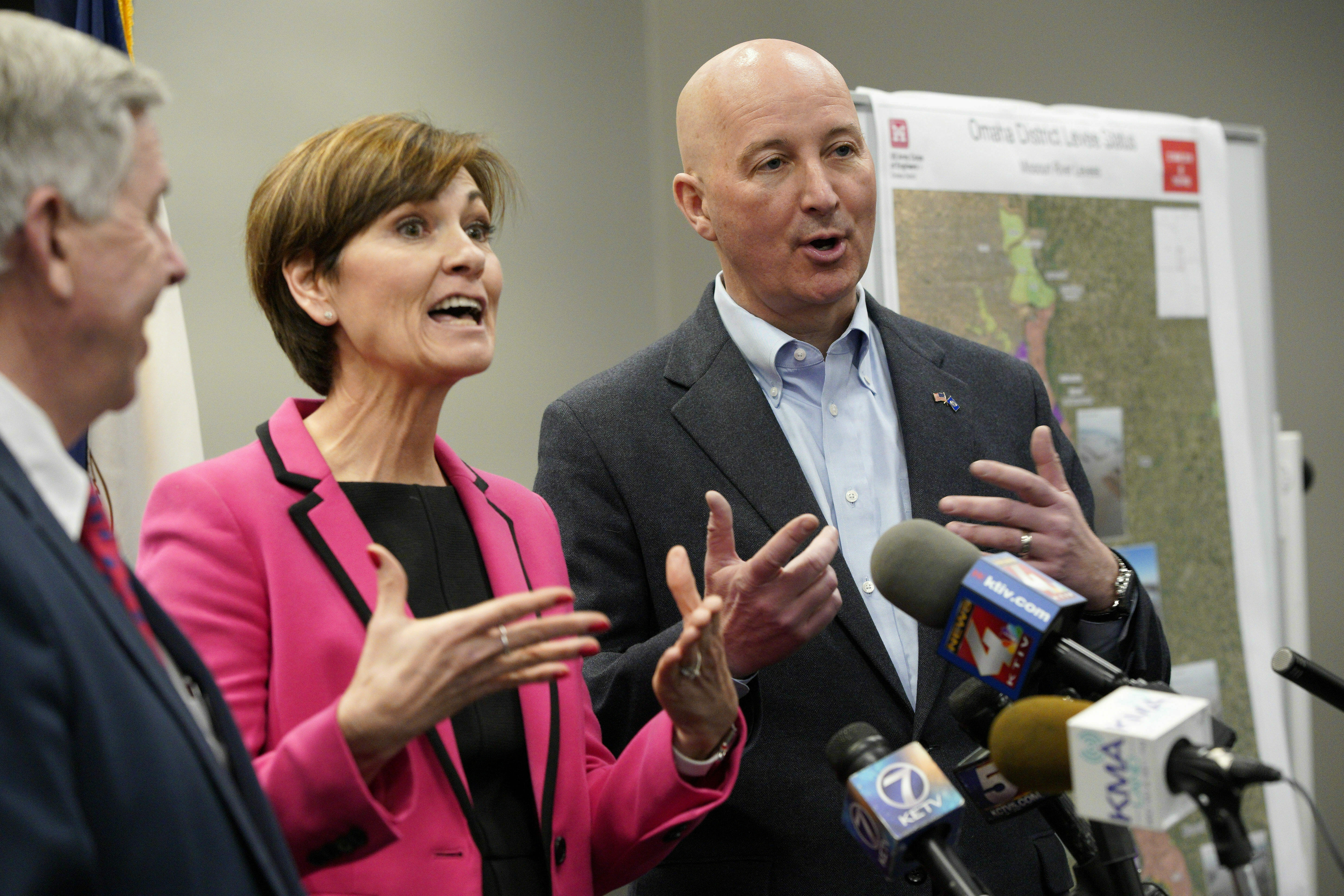
3 Midwest states demand more power over river after floods
COUNCIL BLUFFS, Iowa (AP) — Three Midwestern Republican governors of states ravaged by recent flooding on Wednesday demanded more authority over management of the Missouri River system.
Following a meeting with the U.S. Army Corps of Engineers, Iowa Gov. Kim Reynolds, Nebraska Gov. Pete Ricketts and Missouri Gov. Mike Parson were critical of the federal body that manages the river, saying it should prioritize flood control over other goals, such as protecting fish and wildlife habitat.
“One thing is clear: Something needs to change,” said Parson, who pointed to increasing damage from flooding over the last decade with no solutions in sight.
The governors said they plan to work together for that change, even if it means petitioning Congress to give states more authority in river management.
Ricketts complained that even when funding for reinforcement of levees is approved, it’s often years before the work is actually done. In some cases, flooding repeats before the work even starts. “That permitting process has got to be faster,” he said.
Reynolds said the governors would be presenting a united front to the federal government in demanding more authority.
“We can’t continue to do things like build a temporary levee that would protect a community, and after the Corps deems the flood incident over, require them to tear it down,” she said
Asked whether the Corps indicated it would or could cede some river management decisions to the states, Parson replied, “Well, they listened.”
Kansas Gov. Laura Kelly, a Democrat, also was scheduled to attend but had transportation problems and did not make it.
The Corps has said it works to balance all its priorities and that much of the flooding was well out of its control. The agency said that much of the water that created the flooding came from record rains and melting snow that flowed over frozen ground and directly into the river downstream of its dams, all while massive amounts of water filled Missouri River reservoirs and had to be released.
On Wednesday, the Corps released numbers showing record March runoff in the upper Missouri River Basin above Sioux City, Iowa, of 11 million acre feet — nearly 4 million acre feet more than the previous record of 7.3 million set in 1952. The average March upper basin runoff is 2.9 million acre feet, the Corps said.
Officials have estimated that the flooding caused nearly $1.4 billion in damage in Nebraska and more than $1.6 billion in Iowa. That includes an estimated $1 billion of damage to farms in both states, where flooding destroyed stored crops, tore up land and equipment and killed livestock. Thousands of homes and businesses have been damaged or destroyed in Nebraska alone. The damage total is expected to grow as more assessments are made.
Kansas and Missouri officials are still waiting on damage estimates, although Kansas officials say that state saw flood damage limited to about 31,000 acres of mostly farmland and some stored grain. In Missouri, the surging river caused dozens of levee breaches that inundated about 168,000 acres in Missouri’s two hardest-hit counties of Holt and Atchison.
Officials have said the March floods could be just the beginning of a rough spring, as hefty snowpack in the northern Plains adds to already swollen rivers and streams. That includes the Mississippi River, which started falling Wednesday in St. Louis as the crest moves downstream.
St. Louis closed its floodgates in advance of Tuesday’s crest. Although the flooding there isn’t classified as major, it closed some roads, including stretches of Missouri 94 and 67.
Downstream, the flood fight continues. The Corps said it handed out more than 100,000 sandbags to communities in its St. Louis district, including Clarksville, parts of Jefferson County and Ste. Genevieve.
The Western Journal has not reviewed this Associated Press story prior to publication. Therefore, it may contain editorial bias or may in some other way not meet our normal editorial standards. It is provided to our readers as a service from The Western Journal.
Truth and Accuracy
We are committed to truth and accuracy in all of our journalism. Read our editorial standards.
Advertise with The Western Journal and reach millions of highly engaged readers, while supporting our work. Advertise Today.












